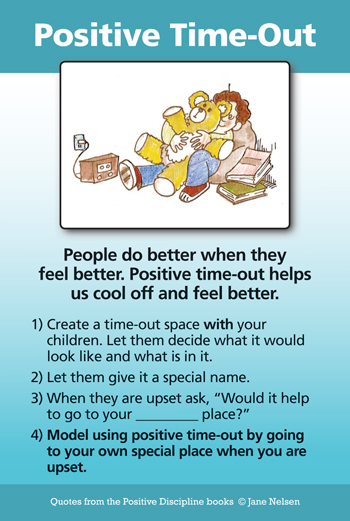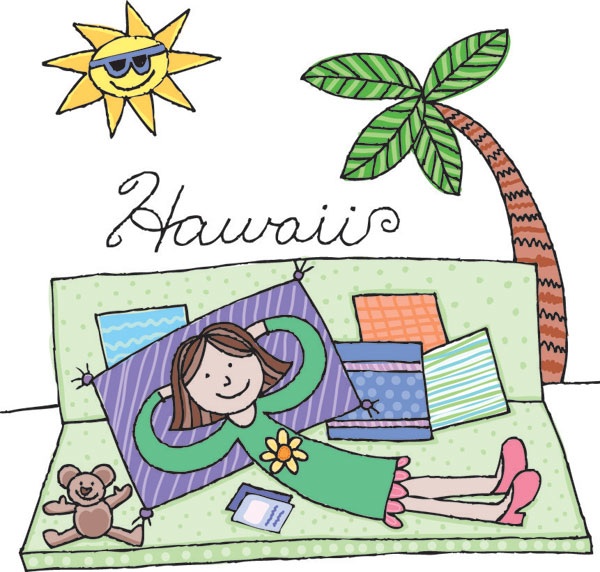by Dr. Jane Nelsen

Imagine you are an employee who has made a mistake, and your boss comes to you and says, “You go to time-out and think about what you have done. And don’t come out until I say you can.” Or, if you are married, imagine your spouse coming to you and saying, “I don’t like your behavior. You are grounded for a week.” In either of these scenario’s what would you be thinking, feeling, and deciding. Is there any chance that you would say, “Oh, thank you so much. This is so helpful. I’m feeling so encouraged and empowered and can hardly wait to do better.” Not likely.
Where did we ever get the crazy idea that we have to make children feel bad before they will do better? This crazy idea is the basis for punitive time-out. It doesn’t work for children any more than it would work for adults.
Children are always making decisions about themselves (am I good or bad, capable or not capable, etc.), decisions about others, (are they supportive, friendly, etc. or not), and then decisions about what they will do in the future. These decisions help create a child's personality (even though many are made at a subconscious level).
When children are sent to punitive time-out, they are likely to be thinking, "I won't get caught next time." "I'll get even." Or, worst of all, "I'm bad." This is why the NAEYC (National Association for the Education of Young Children) is very much against punitive time-out.
Positive Time-Out
Positive time-out is totally different. A child (or students in a classroom) design a "positive time-out area" filled with pleasant things to help them calm down until they can access their rational brains and "Do Better."
After they have designed their "positive time-out area," they can give it another name such as "my space," or my "my cool off spot." Giving positive time-out another name helps eliminate the negative feelings of punitive time-out."
Then allow your child to "choose" to go to his positive time-out instead of being sent. During a conflict you might say, “Would it help you to go to your ‘feel good place?” If your child says, “No,” ask, “Would you like me to go with you?” (Often this is encouraging to a child and helps increase a connection, as well as calming down.) If your child still says, “No,” (or is having such a temper tantrum, she can’t even hear you,) say, “Okay, I’m going to my time-out place.” What a great model for your children.
Go to your own Positive Time-Out

Of course it is a good idea for you to have your own positive time-out area so you can model this self-regulation skill. Going to your own positive time-out may be the best place to start during a conflict. Instead of asking your child if it would help her to go to her feel good place, just go to your own. Your time-out could be a physical place. It could also take place by taking deep breaths, counting to ten (or 100), meditating on how much you love your child, etc.
Not for Children under the age of Three
If a child isn't old enough to design his own positive-time-out area, he is not old enough to understand any kind of time-out—even positive time-out. For this age group we recommend helping them calm down in the moment by sitting in your lap, holding a favorite blanket or pillow, or counting slowly and coaching how to take deep breaths together to calm down. Using these tools early will help develop important life skills for calming down and cooling off.
Choose another Positive Discipline Tool Card
Remember that even positive-time-out is not always the most effective parenting tool to help children learn self-discipline, responsibility, problem-solving skills, and other valuable social and life skills. That is why there are 52 tool cards.
Introducing Jared's Cool-Out Space (Children's Picture Book)
Children, parents, and teachers will enjoy this beautifully illustrated book that teaches the value of "positive time-out" to help children learn self-soothing skills. Co-authored by Jane Nelsen and Ashlee Wilkin, and illustrated by political cartoonist, Bill Schorr. Click Here for More Information.
Listen below to an excerpt from Building Self-Esteem Through Positive Discipline.



Comments
Reframing words
These strategies are great to use. I have used them before in my class and they do work. I feel like the language we use with the child makes a huge difference. We might not notice but when we reframe the sentence and try to speak with the children using positive discipline we will be able to give them logical consequences for their actions and the student will take responsiblity of the choices they made.